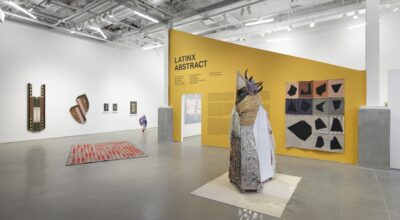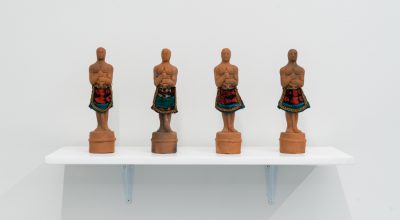
PABLO GÓMEZ URIBE: ALL THAT IS SOLID
[et_pb_section bb_built=»1″][et_pb_row][et_pb_column type=»4_4″][et_pb_text _builder_version=»3.2.2″]
By Karen Grimson
…Our revels now are ended. These our actors,
As I foretold you, were all spirits and
Are melted into air, into thin air…
Prospero, The Tempest
When the artist Carl André’s Equivalent VIII (1969) was acquired by London’s Tate Gallery and installed in their permanent collection galleries in 1975, the minimalist work was ridiculed and dismissed as “a pile of bricks”. In its defense, critics were forced to explain that Minimalism “produces serious art whose aim is to simplify and reduce, to eliminate easy appeals to the eye and to focus the viewers’ attention on the primitive dimension that art possesses when stripped of its visual rhetoric.” [1] This kind of discourse and understanding owed much to the pioneering work of Marcel Duchamp, who conceived of his ready-mades as strategies to promote an ‘aesthetics of indifference’— a dismissal of art’s visual importance (its retinal hegemony), and a complete obliteration of the prevailing parameters of good and/or bad taste.
Born in Medellin that same year, the oldest son of a real estate broker and a psychoanalyst, Pablo Gómez Uribe came of age during the aftermath of Colombia’s most violent years, amidst the country’s war on drugs, and the incipient (if still unresolved) peace process. A society wounded by the legacy of civil war and trauma, Colombia’s struggles are partly rooted in the swaying politics of memorialization and erasure [2]. Through his formation (and deformation) in Architectural studies, Gómez Uribe developed a commitment to structural solidity that has all but inhibited his fascination with the instability of forms. Bricks—central elements of his artistic vocabulary—are the modular building blocks, the irreducible unit, and the most ambiguous sign of labor: deceptive in the dual connotation of their assembly as both a suggestion of construction (a work in progress), or collapse (a scene of disintegration). Fittingly, one of the first works in the exhibition, Tridimensional Palimpsest, consists of 200 bricks of pumice stone that trace the architectural memory of Proxyco’s former floor plan.
[/et_pb_text][et_pb_image _builder_version=»3.2.2″ src=»https://artishockrevista.com/wp-content/uploads/2018/12/DSC4475.jpg» show_in_lightbox=»on» alt=»Installation view of Pablo Gómez Uribe’s “All that is Solid”, at Proxyco Gallery, New York, 2018. Photo: Javier Morales» title_text=»Installation view of Pablo Gómez Uribe’s “All that is Solid”, at Proxyco Gallery, New York, 2018. Photo: Javier Morales» /][et_pb_image _builder_version=»3.2.2″ src=»https://artishockrevista.com/wp-content/uploads/2018/12/DSC4476.jpg» show_in_lightbox=»on» alt=»Installation view of Pablo Gómez Uribe’s “All that is Solid”, at Proxyco Gallery, New York, 2018. Photo: Javier Morales» title_text=»Installation view of Pablo Gómez Uribe’s “All that is Solid”, at Proxyco Gallery, New York, 2018. Photo: Javier Morales» /][et_pb_text _builder_version=»3.2.2″]
Central to the exhibition space, Family’s Manifest—an explicit reference to Carl André’s Manifest Destiny (1986)—on view as a permanent installation at the Judd Foundation, merely a mile away from the gallery—charts the genealogical origin of the artist’s self-nomenclature. Opposite to André, whose work features the slogan of 19th century American imperialism, Family’s Manifest presents viewers with the constitutive vertebrae of a single individual, the constructive condition of an everyday man, the ordinary hero.
The artist’s most recent proclamation, MEDENYAL, is a conjunction of his dual citizenship (Medellin and New York), and the inherent self-obliterating nature of their architectures. As a Homo Faber specializing in demolitions, Gómez Uribe questions the limits of the object’s constructability: bricks are sent out for testing, and their failure reclaimed as art. This celebration of accident brings to mind Duchamp’s Great Glass (The Bride Stripped Bare by Her Bachelors, Even), “finally unfinished” in 1923, which notoriously broke in transit when being returned from loan at the Brooklyn Museum [3].
By welcoming the results of procedural testings into his work, Gómez Uribe targets the notion of Architecture as an arena of uncontested progress, problematizing the conflicting relationship between modernism and modernization. His series of Mod-jects (Rocking, Shaking, Orbiting) resemble machines used by scientists in laboratory testing, a symbolic product of which can be found across the gallery space, in the five Tested Bricks that resulted from a process of industrial testing. The cracks that have crystallized on the surface of these wooden samples (cracks that carry the memory of trauma, prototypes baring the sign of malfunction) are perhaps the artist’s most cherished bit of information. Inverting the logic of aesthetics and the visually appealing, these tested samples set the intention for the artist’s entire body of work: they remind us that bricks —in spite of their impeccable regularity— are not to be defined by their beauty, or the way they appear to our eyes, but by the possibilities they contain (revealed finally upon testing). In order to question the narratives of beautification, Gómez Uribe produces a space of fiction (the Tested City) where metaphor can flourish, generating the possibilities for an invented identity to emerge.
[/et_pb_text][et_pb_image _builder_version=»3.2.2″ src=»https://artishockrevista.com/wp-content/uploads/2018/12/Natural-Untested-Pumice-Brick.jpg» show_in_lightbox=»on» alt=»Pablo Gómez Uribe, Natural Untested Pumice Brick #1,2,3,4,5, 2018, 5 pumice bricks, 19.05 x 8.90 x 6.35 cm/7.50 x 3.50 x 2.50 in. Photo: Javier Morales » title_text=»Pablo Gómez Uribe, Natural Untested Pumice Brick #1,2,3,4,5, 2018, 5 pumice bricks, 19.05 x 8.90 x 6.35 cm/7.50 x 3.50 x 2.50 in. Photo: Javier Morales » align=»center» /][et_pb_image _builder_version=»3.2.2″ src=»https://artishockrevista.com/wp-content/uploads/2018/12/Pablo-Gomez-Models-of-Familys-Manifest-2018.jpg» show_in_lightbox=»on» alt=»Pablo Gómez Uribe, Family’s Manifest, 2018, 8 clay bricks, 19.05 x 8.90 x 6.35 cm/7.50 x 3.50 x 2.50 in. Ed. 3+1AP. Photo: Javier Morales» title_text=»Pablo Gómez Uribe, Family’s Manifest, 2018, 8 clay bricks, 19.05 x 8.90 x 6.35 cm/7.50 x 3.50 x 2.50 in. Ed. 3+1AP. Photo: Javier Morales» align=»center» /][et_pb_image _builder_version=»3.2.2″ src=»https://artishockrevista.com/wp-content/uploads/2018/12/UnSeated-Chair.jpg» show_in_lightbox=»on» alt=»Pablo Gómez Uribe, The Un-seated Chair/A Park’s Proposal, 2018, painted wood, 81.3 x 35.6 x 38.1 cm/32 x 14 x 15 in. Ed.1+1AP. Photo: Javier Morales » title_text=»Pablo Gómez Uribe, The Un-seated Chair/A Park’s Proposal, 2018, painted wood, 81.3 x 35.6 x 38.1 cm/32 x 14 x 15 in. Ed.1+1AP. Photo: Javier Morales » align=»center» /][et_pb_text _builder_version=»3.2.2″]
In the ambiguity of global capitalism, where seeming permanence is designed for obsolescence, triumphant architectural developments that follow the beat of real estate drums are destined for decay, disintegration and disappearance. As Marshall Berman best explained it (when he quoted Marx quoting Shakespeare), “to be modern is to find ourselves in an environment that promises us adventure, power, joy, growth, transformation of ourselves and the world—and, at the same time, that threatens to destroy everything we have, everything we know, everything we are.” [4]. It is precisely the idea of progress that Gómez Uribe’s practice attempts to destabilize, even if his critique of construction and the ever-developing real estate market leaves behind nothing but “a pile of bricks,” a bunch of melting solids in a state of perpetual disintegration.
(1) Robert Semple Jr., “Tate Gallery Buys Pile of Bricks—Or Is It Art?” New York Times, February 20, 1976, p. 34.
(2) See Guillermo Zuluaga, “Demolición del Mónaco: ¿ocultar la basura debajo del tapete?” El Espectador (Bogotá), September 30, 2018.
(3) See Octavio Paz, Marcel Duchamp or the Castle of Purity (London: Cape Goliard Press, 1970).
(4) Marshall Berman, All That is Solid Melts into Air (New York: Penguin Books), p. 15.
[/et_pb_text][et_pb_text _builder_version=»3.2.2″ custom_padding=»25px|25px|25px|25px» border_width_all=»1px» border_color_all=»#9b9b9b»]
PABLO GÓMEZ URIBE: ALL THAT IS SOLID
Proxyco Gallery, 168 Suffolk St., New York, NY
November 14 – December 22, 2018
[/et_pb_text][/et_pb_column][/et_pb_row][/et_pb_section]
También te puede interesar
TWO EXHIBITIONS HIGHLIGHT LATINX ARTISTS’ ABSTRACT APPROACH
Two groundbreaking exhibitions currently on view in New York assert the enduring legacy of abstraction among Latinx artists: “Latinx Abstract” at BRIC, curated by Elizabeth Ferrer, and “XX”, at the Manhattan-based LatchKey Gallery. Both...
TÓTEMS Y TROFEOS
"Tótems y trofeos" examina el valor y el significado que la sociedad atribuye a los objetos, desde la carga emocional de un trofeo y el valor histórico de un monumento hasta la forma en...
BORN IN FLAMES: FEMINIST FUTURES
“Born in Flames” highlights a number of artists referencing non-Western folklore and mythologies to create alternate futures. Their works are representative of how each artist is thinking about futurism––including Afro-, Asian-, Indigenous-, and Latinx-futurism,...



